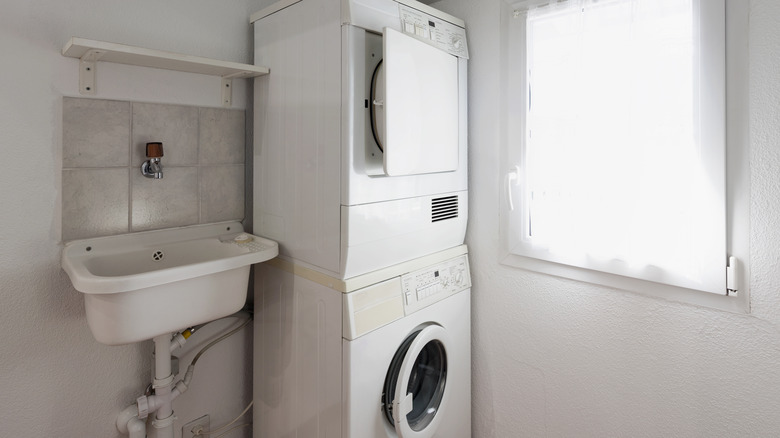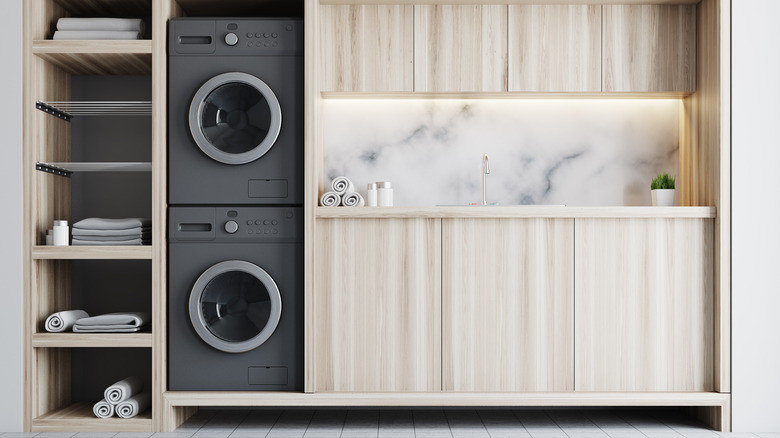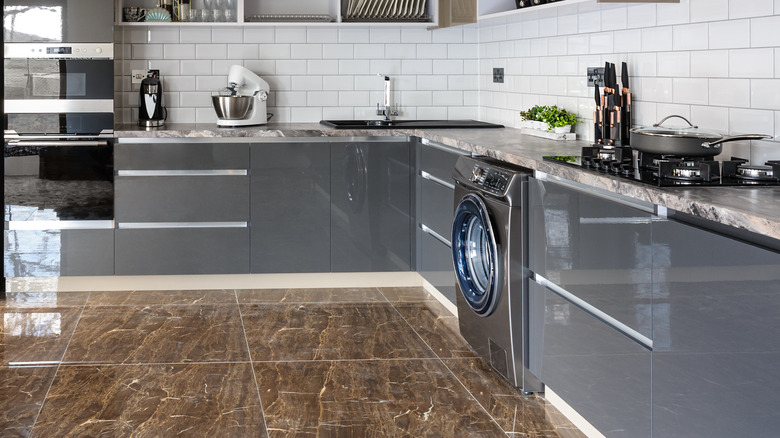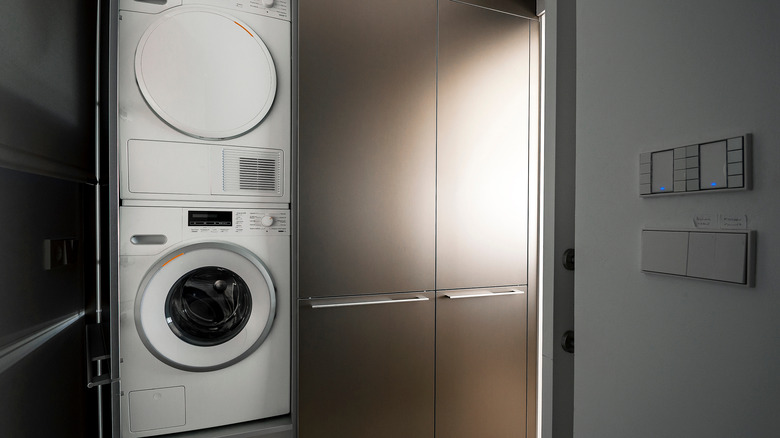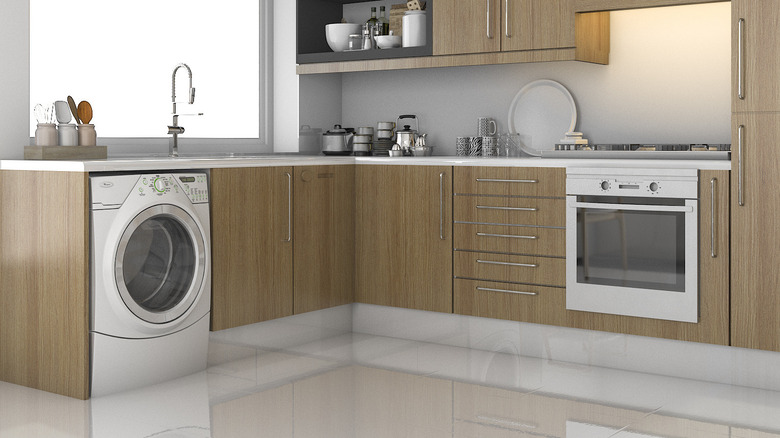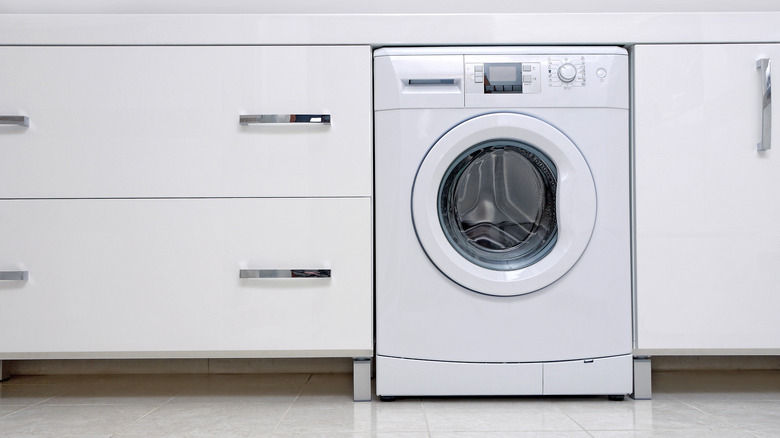Stackable Vs. Integrated Laundry Machines: What's The Difference?
Having both a washing machine and a dryer in your home provides a convenient, and for some necessary, amenity that makes life much easier. What's not so convenient, though, is finding a suitable location for the machines. If you don't have a dedicated laundry room, choosing a place to install them can be a major headache.
Thankfully, laundry machine manufacturers are aware of this issue, and there are several models designed to combat it. Of the different models available, stacked laundry machines and integrated laundry machines are the most common. Stacked laundry machines are just what they sound like, a dryer stacked on top of a washing machine. Integrated laundry machines, on the other hand, refer to machines that are discreetly built into a cabinet (usually in a kitchen), with a door covering the machine to make it look like a part of the room, explains Home Questions Answered. While both styles are great for saving space, they have different practical and aesthetic purposes.
How does the appearance differ?
In terms of outward appearances, there's plenty of variety for both stacked and integrated laundry machines. The visual difference mainly comes from the layout of the controls; stacked machines are vertically-oriented, whereas integrated machines tend to be horizontally-oriented. According to Appliances Online, there are generally two types of stacked laundry machine designs, but both follow the same general rule with the dryer on top and the washer underneath. This is because washing machines are heavier and tend to vibrate more.
The most common type of stacked laundry machine comprises two separate units that can either slot together or be used individually. The other less common design is referred to as a laundry center and is a single unit with a dryer at the top and a washer at the bottom, notes Don's Appliances. Integrated laundry machines, however, vary somewhat in style and material, since they are designed to be concealed within a cabinet.
What are the differences in cost?
There are a few differentiating factors in terms of the cost between a stacked laundry machine and an integrated design, according to Don's Appliances. This is mainly due to the fact that integrated machines often require complex installation as well. The price of a stacked laundry machine depends on both the design and the range of optional extras. A basic laundry center starts at around $1,400, while high-end designs increase to $1,750. The price of individual stackable machines tends to be a little higher, ranging from $1,800 to as much as $3,000 for a top-of-the-range model (via Lowe's).
When it comes to integrated washing machines, factors such as where it's being installed, and how difficult the construction process is, will affect the price. According to Kitchen Insider, though, integrated washing machines tend to be pricier when compared to standard, freestanding or stackable washing machines.
Pros and cons of stackable laundry machines
Both stackable and integrated laundry machines are preferred by many since they fit better in smaller spaces and are a little more discreet than standard, freestanding washing and drying machines. They aren't the same machine, though, and they both serve slightly different purposes. With stackable washing machines, HomeServe points out that an obvious plus is how easy it is to slot them into a spare closet or a bathroom without taking up too much space. They are also great if you have difficulties bending over, as they just require you to take the laundry out of the bottom and put it on top in the dryer, as opposed to bending down for each machine.
That being said, stackable units tend to be smaller in terms of capacity and can be a little pricier than freestanding, individual machines. Additionally, one-piece laundry centers may not be separated, making it hard to redesign your laundry room in the future.
Pros and cons of integrated laundry machines
Integrated laundry machines are also ideal for saving space. They are more discreet, neatly fitting into your kitchen cabinets or laundry room. Therefore, the most obvious benefit is their hidden appearance, and as Kitchen Insider points out, the cabinet door also helps make the machine quieter.
In terms of downsides, a big one is the cost and difficulty of installation. Moreover, once installed, it can't very easily be relocated, and it also takes away precious kitchen cabinet space. Integrated or built-in machines are usually just the washer, too, meaning you'll have to find another spot for your dryer or dry your clothes outside. Additionally, integrated washers tend to have smaller loading capacities, as they have to be thinner and shorter to fit properly under the cabinet.
Recommended use of each
Overall, stackable and integrated laundry machines are both great options for small spaces, but that's not where their usefulness ends. As noted, stackable machines are great for people who can't bend down so easily (or who simply don't want to). Alternatively, combination machines don't even require that, as they tend to be top-loading. And, while they're not the most discreet model on the market, they are usually hidden away better than freestanding machines, notes General Appliance Service.
Integrated or built-in laundry machines are more suitable for people who value the aesthetic presence of an item over its functionality. That isn't to say integrated machines don't work well, but the focus is more on hiding the machine in plain sight. However, if your kitchen is low on storage space as it is, then an integrated machine isn't the best option as it takes up too much valuable cabinet space.
